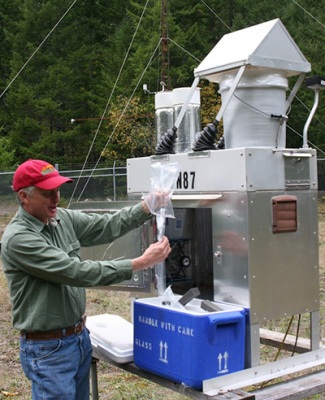Jan 28 2016
An analysis of long-term trends in the amount of mercury in rainfall and other forms of precipitation in North America found recent increases at many sites, mostly in the center of the continent. At other sites, including those along the East Coast, mercury levels in rainfall have been trending steadily downward over the past 20 years.
 Monitoring sites like this one in Oregon maintained by the U.S. Forest Service collect precipitation samples which are then analyzed for mercury, sulfate, nitrate, and other pollutants. (Photo courtesy of Mark Brigham, U.S. Geological Survey)
Monitoring sites like this one in Oregon maintained by the U.S. Forest Service collect precipitation samples which are then analyzed for mercury, sulfate, nitrate, and other pollutants. (Photo courtesy of Mark Brigham, U.S. Geological Survey)
The findings are consistent with increased emissions of mercury from coal-burning power plants in Asia and decreased emissions in North America, according to Peter Weiss-Penzias, an environmental toxicologist at UC Santa Cruz. Weiss-Penzias is first author of a paper on the findings published in the journal Science of the Total Environment (in press, available online).
Mercury is a toxic element released into the environment through a variety of human activities, including the burning of coal, as well as by natural processes. Rainfall washes mercury out of the atmosphere and into soils and surface waters. Bacteria convert elemental mercury into a more toxic form, methyl mercury, which becomes increasingly concentrated in organisms higher up the food chain. Mercury concentrations in some predatory fish are high enough to raise health concerns.
Monitoring network
In the new study, researchers analyzed data from a network of monitoring sites in the United States and Canada that collect measurements of mercury in precipitation. The network has been collecting data since 1997, but monitoring sites were initially concentrated in the eastern United States, while sites in the Midwest, Rocky Mountain, and West Coast regions were added only relatively recently. The long-term dataset extending back to 1997, which represents mostly the eastern regions, showed an overall decline in mercury concentrations. But when the researchers looked at more recent time periods starting in 2007 or 2008, they found many sites with significant positive trends in mercury concentrations.
"This hadn't been observed before, and the sites with positive trends were primarily concentrated in the Intermountain West and in the central part of the continent, in the Rocky Mountain, Plains, and Midwest regions," Weiss-Penzias said. "On the Eastern Seaboard, the trend was still largely negative even for the shorter time periods."
Coauthor Mark Brigham of the U.S. Geological Survey noted that the findings are broadly consistent with other recent reports of decreasing atmospheric mercury deposition in North America since about 1997, but with a new twist.
"By examining trends in more detailed time increments and more geographic detail, we saw that in recent years the long-term decreasing trend has leveled off, and some sites in the western U.S. are even seeing increases, which we think is due to increasing mercury emissions from Asia," Brigham said. "So the reductions in North American mercury emissions are primarily benefiting the eastern U.S., where there is a greater concentration of emissions."
The researchers also looked at trends in sulfate concentrations in rainfall, which is an indicator of local sources of emissions from coal combustion. While mercury and sulfate concentrations were closely correlated at East Coast monitoring sites, other sites showed a stark contrast between rising mercury concentrations and falling sulfate concentrations.
"This indicates that mercury emissions in the U.S. and Canada are not the cause for the observed upward tendencies in mercury concentrations," Weiss-Penzias said.
Emission controls
Mercury emissions have declined in North America and Europe for several reasons, including better emissions controls and increasing use of natural gas rather than coal as a fuel for power plants. The "scrubber" systems installed at coal-fired power plants in North America and Europe since the early 1990s to combat acid rain also reduce mercury emissions.
Emissions from Asia have been increasing, however, and are transported over long distances in the upper atmosphere. The influence of the Sierra Nevada and Rocky Mountains on weather systems results in mercury from the upper atmosphere being deposited in precipitation in western states such as Nevada and Idaho and in the central United States, Weiss-Penzias said.
The researchers also looked at trends for concentrations of gaseous mercury in the atmosphere, although less data are available than for mercury in rainfall. By merging several short-term datasets for air concentrations in North America, they found the trends were similar to the pattern for mercury in rainfall: a downward trend for the early time period (1998-2007), shifting to a flat slope for the recent period (2008-2013).
"A lot less mercury is being emitted to the atmosphere in the U.S. and Canada than 20 years ago as a result of regulations, efforts by industry, and the economic realities of cheap natural gas," Weiss-Penzias said. "In spite of that, there are other factors, including emissions from other parts of the world, that are causing an increase in the amount of mercury being deposited in certain locations in North America."
In addition to Weiss-Penzias and Brigham, the coauthors of the study include David Gay, coordinator of the National Atmospheric Deposition Program (NADP) and the NADP's Mercury Deposition Network; Matthew Parsons at the Meteorological Service of Canada, Environment Canada; Mae Gustin at the University of Nevada, Reno; and Arnout ter Schure at the Electric Power Research Institute (EPRI). Funding for the study was provided by EPRI.